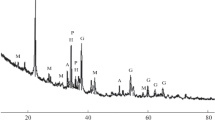Conclusions
Experimental work was carried out to obtain from bromine liquors of bischofite of the Volgograd deposits magnesium oxide, using low capacity industrial equipment for chemical purification of magnesite, including a recuperator, a tank-collector, a spray-reactor, a cyclone, an absorption column, spray traps, a vacuum pump, and a filter press.
We worked out the parameters for the processes of boiling off the liquor, thermohydrolysis of the magnesium chloride, absorption of the hydrogen chloride with the production of hydrochloric acid, washing and leaching the hydrolytic magnesium oxide, and filtration of the resulting magnesium hydroxide. During the reprocessing of the liquor containing the bischofite, using this technology, without preliminary purification to remove boron and sulfates, we obtained magnesium hydroxide with a high purity level (98.5–99.5% MgO on the calcined weight).
It is shown that the magnesium hydroxide thus obtained is a high-quality raw material for the production of fused and sintered periclase with a purity of 98–99.5% MgO. The technology of sintering, including carbonization of the magnesium hydroxide, hot palletizing without bond, and firing at moderate temperatures, ensures the production of densely sintered periclase. Tiles with inserts made from fused periclase of high purity with a clear anisotropic structure facilitate the casting of two heats through the gate valves.
The results obtained can serve as the starting data for the development of specifications (TLZ) and planning the production of magnesium oxide from the debrominized bischofite liquors at the Volgograd site using the thermohydrolysis method. We need to solve the problem of the use of the 20% HCl that is obtained.
Similar content being viewed by others
Literature cited
V. A. Reznikov, Perpsectives for the development of complex use and reprocessing of bischofite deposits; Review of Information [in Russian], Ser. Development of Potash Industry, NIITÉKhIM (1976).
A. K. Kreshkov, Principles of Analytical Chemistry [in Russian], Vol. 2, Khimiya (1971), p. 472.
Methods of Analyzing Liquors and Salts [in Russian], Khimiya, Moscow (1964), p. 404.
V. A. Smertin, E. B. Glezer, K. V. Simonov, et al., Ogneupory, No. 11, 18–23 (1984).
K. V. Simonov, Ogneupory, No. 3, 27–31 (1983).
Inventor's Certificate No. 1235858, K. V. Simonov, V. N. Koptelov, et al., Otkrytiya Izobret., No. 2, 82 (1986).
K. V. Simonov, Ogneupory, No. 3, 20–24 (1986).
K. V. Simonov, V. A. Kryuchkov, and A. G. Luzin, Ogneupory, No. 11, 36–39 (1986).
K. V. Simonov, V. N. Koptelov, I. T. Lysov, et al., Ogneupory, No. 3, 28–36 (1981).
Author information
Authors and Affiliations
Additional information
Translated from Ogneupory, No. 1, pp. 27–30, January, 1988.
Rights and permissions
About this article
Cite this article
Simonov, K.V., Glezer, E.B., Afinogenova, N.S. et al. Obtaining magnesia and periclase refractories from bischofite from the volgograd deposits. Refractories 29, 34–38 (1988). https://doi.org/10.1007/BF01386603
Issue Date:
DOI: https://doi.org/10.1007/BF01386603




